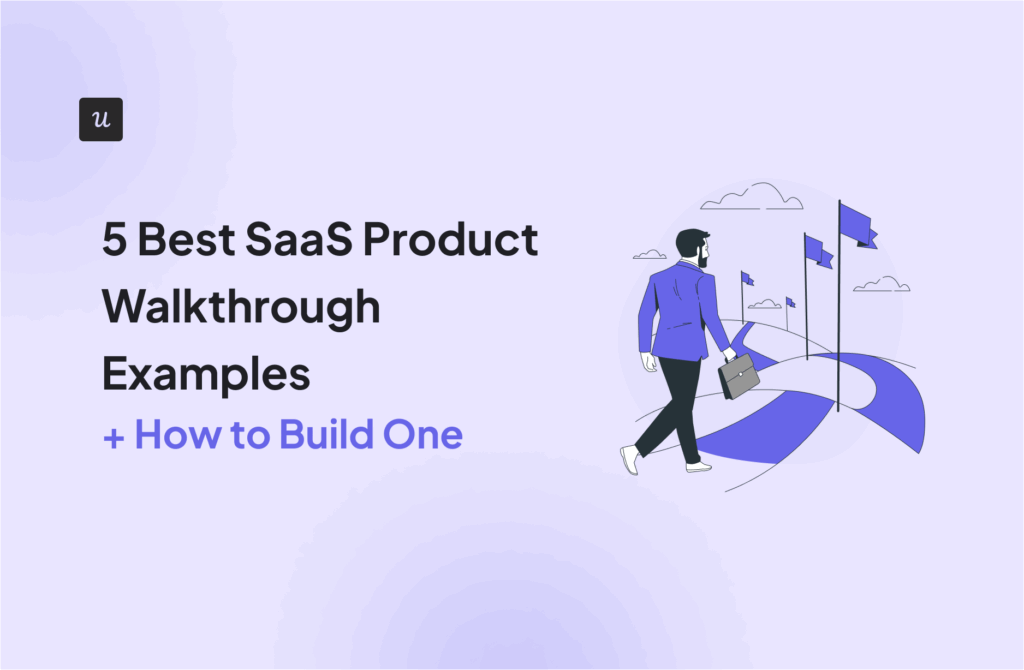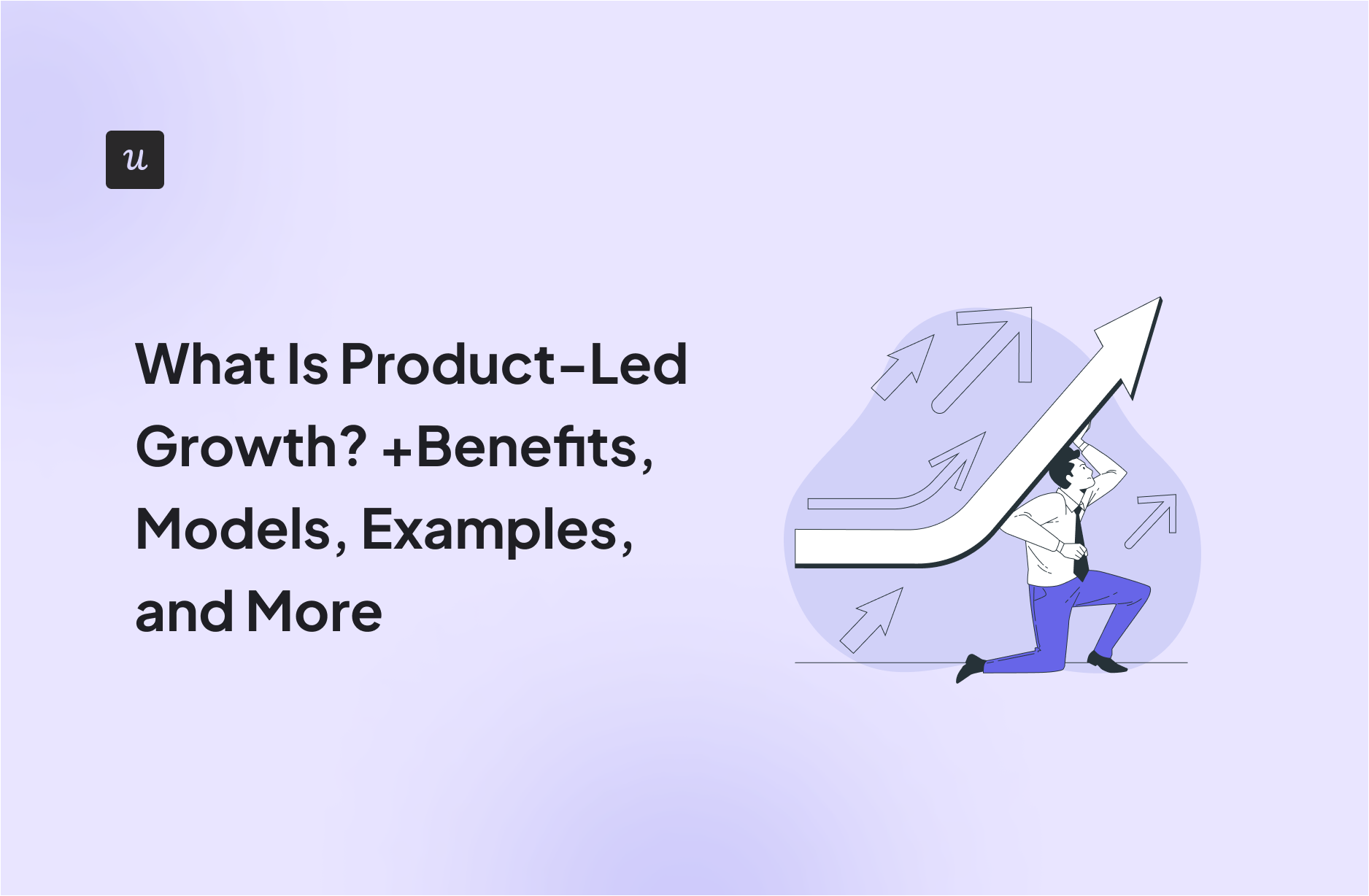
Is product-led growth a fad or here to stay?
Looking at thriving product-led businesses like Slack and Grammarly, you might be tempted to adopt this growth strategy. But what are the possible consequences, both positive and negative, of this model? And how do you make the switch from a traditional growth model to one that’s driven by your product?
We unpack the above questions and many more in this article. Keep on reading.
Get The Insights!
The fastest way to learn about Product Growth, Management & Trends.
What is product-led growth?
Product-led growth, or PLG for short, is a business strategy that leverages the product as the main driver to acquire, activate, and retain customers.
The approach is based on the idea that if the product satisfies user needs and offers a great user experience, it requires fewer sales and marketing efforts to attract and retain them. That’s because satisfied users promote the product for you through word-of-mouth marketing and referral schemes.
Why is there a need for product-led growth?
Over recent years, we have seen changes in customer expectations towards products.
Customers don’t only expect powerful functionality that enables them to achieve their goals but also want the products to be intuitive and visually appealing and offer personalized user experiences.
What’s more, studies show that modern customers prefer self-service when buying and exploring products.
Over 53% prefer to make purchase decisions without any interactions with the sales team, and 20% of B2B customers are happy to do so for single purchases between $500k and $5 million, according to a 2021 McKinsey study.
As per another study, 42% of your users would rather clean the toilet than talk to support!
What are the benefits of following a product-led growth strategy?
PLG initiatives offer a number of advantages for SaaS businesses.
Lower customer acquisition costs
In the PLG approach, existing customers drive customer acquisition. Through a combination of WOM and referral schemes, they promote the product in their professional and social circles. This reduces the cost involved in running the marketing departments (but doesn’t eliminate it completely).
What’s more, self-service onboarding, training, and support resources enable users to explore the product at their own pace.
This reduces the burden on the customer support and customer success team. Self-serve purchases also free up the sales team so that they can focus on enterprise sales.
Higher customer retention rates
Product-led growth leads to better customer retention because it focuses on delivering real value from the start. When users find a product easy to use and immediately beneficial, they’re more likely to stay engaged and keep using it.
This also means higher customer lifetime value because retained and satisfied customers are more receptive to upgrade messages.
Sustainable and scalable SaaS growth
Reduced dependence on customer support, customer success, or sales teams enables SaaS organizations to grow in a sustainable way.
That’s because the number of customers that the company can support doesn’t depend on the number of employees and allows the company to scale up and down depending on the demand.
PLG business can focus the resources they save in this way on developing innovative features and products that even better address user needs and wants. This increases customer satisfaction and further drives organic customer acquisition.
Challenges of the product-led growth strategy
There’s no one better to ask this question from than Wes Bush, a seasoned expert in product-led growth. In an interview with him, he said that the major challenge with PLG is the misconception that it’s only about having a free model and transparent pricing.
Many overlook the crucial underlying elements needed for success. Effective PLG requires a supportive product-led organization organization, a clear strategy, the right teams, capabilities, and robust data.
Without these, you can’t accurately track user value or conduct meaningful experiments to enhance the experience. Ignoring these foundational aspects often leads to failure in implementing PLG effectively.
How to avoid common PLG challenges?
To avoid falling into common product-led growth traps, Wes Bush suggests building a strong productled organization (PLO). To learn more about what PLO is and how to transition to the PLG model successfully, watch the video below or read the interview here.
3 product-led growth models to choose from
To give users an opportunity to experience the product and realize its value before converting into paid customers, product-led businesses use two models, freemium or free trial, or a combination of them.
1. Freemium model
In this product-led growth model, users can use the product for free but with limited functionality or low usage limits.
This gives them a chance to experience the Aha! moment but doesn’t satisfy all their needs, so they have the motivation to upgrade to a paid plan.
Freemium is an effective way to quickly build your customer base. It could be an advantage for businesses that are still looking for their PMF and need customer data to iterate on or depend on the network effect.
However, organizations need robust technical infrastructure and customer support to support it.
Miro is one company with a very popular freemium model.

2. Free trial model
The free trial model offers users access to all features but for a limited time only. When the trial ends, they can no longer use the product.
The free trial is an opportunity to showcase the whole product functionality and evoke FOMO in users so that they upgrade when it ends.
This model generates fewer sign-ups but has a higher conversion rate than freemium. This is particularly the case when users are asked to submit their credit card details when they first sign up (this also causes extra friction, so some potential customers may drop out at this stage).
An example of a company that offers a free trial is Basecamp.

3. Mixed model
Many SaaS organizations combine the two approaches.
One way to do it is through reverse trials. When users sign up, they automatically gain access to full functionality. However, this is only for a limited period, after which they go back to the limited free plan – unless they upgrade.
Loom leverages reverse trials to provide immediate value, motivating users to upgrade to paid plans.

Instead of offering the free trial at the beginning, you can also do it later on. Companies like LinkedIn or Strava offer users free 30-day trials so they can experience the premium features.
How to become a product-led company?
There are a few tactics that marketing and sales-led companies can leverage to transition into a PLG machine.
Foster a product-led culture within your company
For your PLG motions to be successful, all the teams need to embrace and follow the product-led growth methodology.
Why does it matter?
Product-led growth is a team effort that requires the collaboration of teams from across the organization at all stages of the funnel.
For example, marketing teams are responsible for customer acquisition and work with sales teams to drive account expansion. Product teams and customer success teams work closely on user onboarding to drive activation and retention rates.
What’s more, all of the teams contribute their unique insights that guide product development.
Pro tip: invest in data democratization to break up data silos and enable information sharing and effective communication between departments.
Reduce time to value through a personalized onboarding process
To retain your newly signed-up customers, make sure that they experience the product value as quickly as possible.
One way to reduce time to value is by personalizing the onboarding process.
In this way, users discover the features that matter the most to their use cases.
What’s more, tailoring the onboarding flows to different user personas’ JTBDs reduces the information overload. Apart from causing fatigue, receiving lots of information about irrelevant features could lead the new user to the conclusion that the product is not suitable for them after all.
Pro tip: use welcome surveys to identify user needs as soon as they join and use the data to customize the onboarding flow.
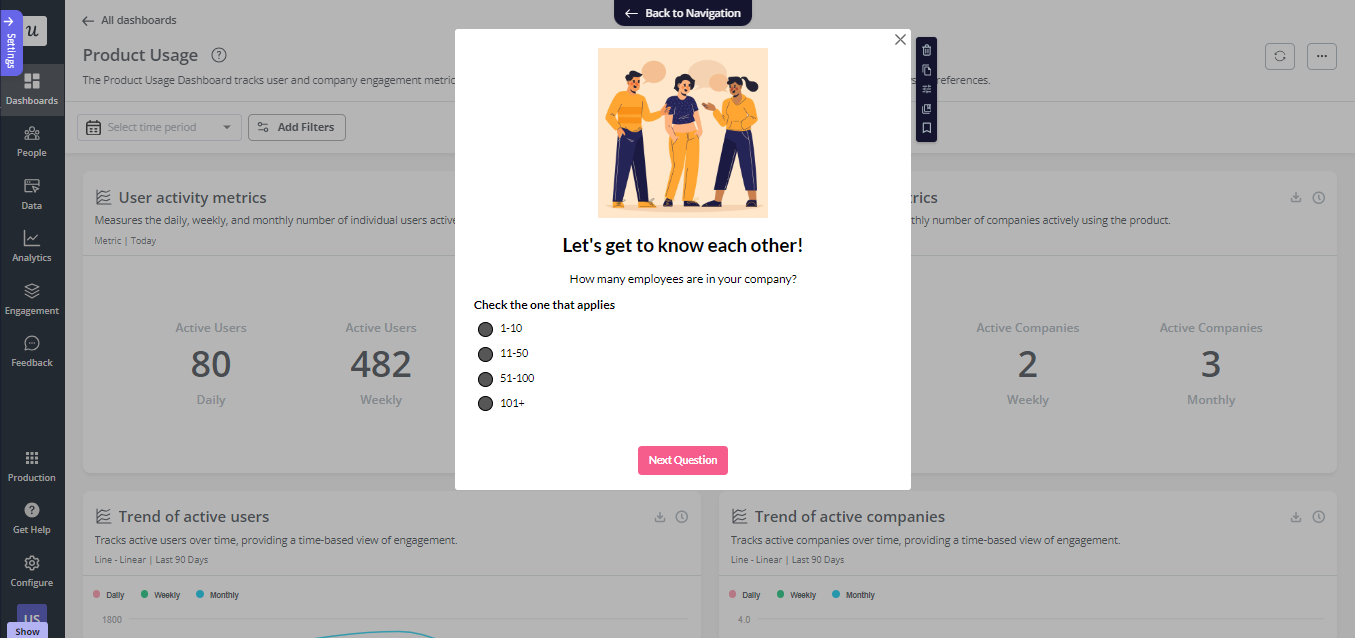
Drive expansion revenue growth through contextual upsell messages
Contextual upsell messages can improve your free to premium conversion rate considerably.
This is because users are much more likely to upgrade to a premium plan when they experience the need to do so first-hand.
For example, a user who has just used a template to streamline their workflow will see the benefit of upgrading to a paid plan that offers unlimited access to templates, so this is the moment to give them a nudge.
Pro tip: pick an engagement software tool, like Userpilot, that enables you to trigger event-based in-app messages so that you can prompt users to upgrade when they complete a specific action.
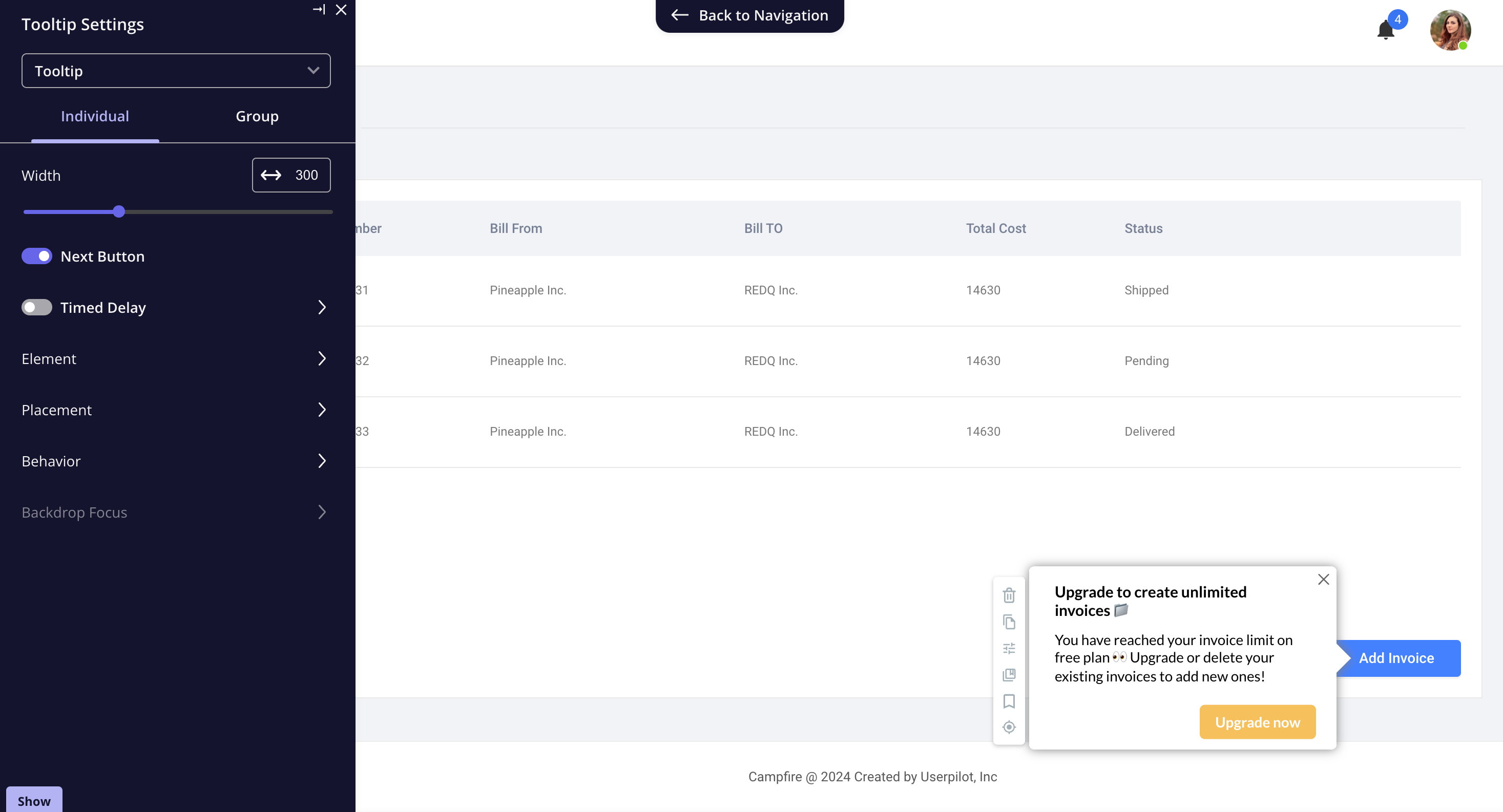
Remove friction by monitoring product usage analytics
Friction delays the moment users experience the product value and adopt it, so make sure to streamline the customer journey as much as you can.
To find friction, use product analytics.
Start by conducting a funnel analysis to assess the conversion rates and time to convert for each stage in the journey. Next, use session recordings to identify the specific issues that slow users down or cause their drop-offs.
Pro tip: leverage user segmentation to analyze the in-app behavior of the most successful users and identify the happy path for users with a particular use case.
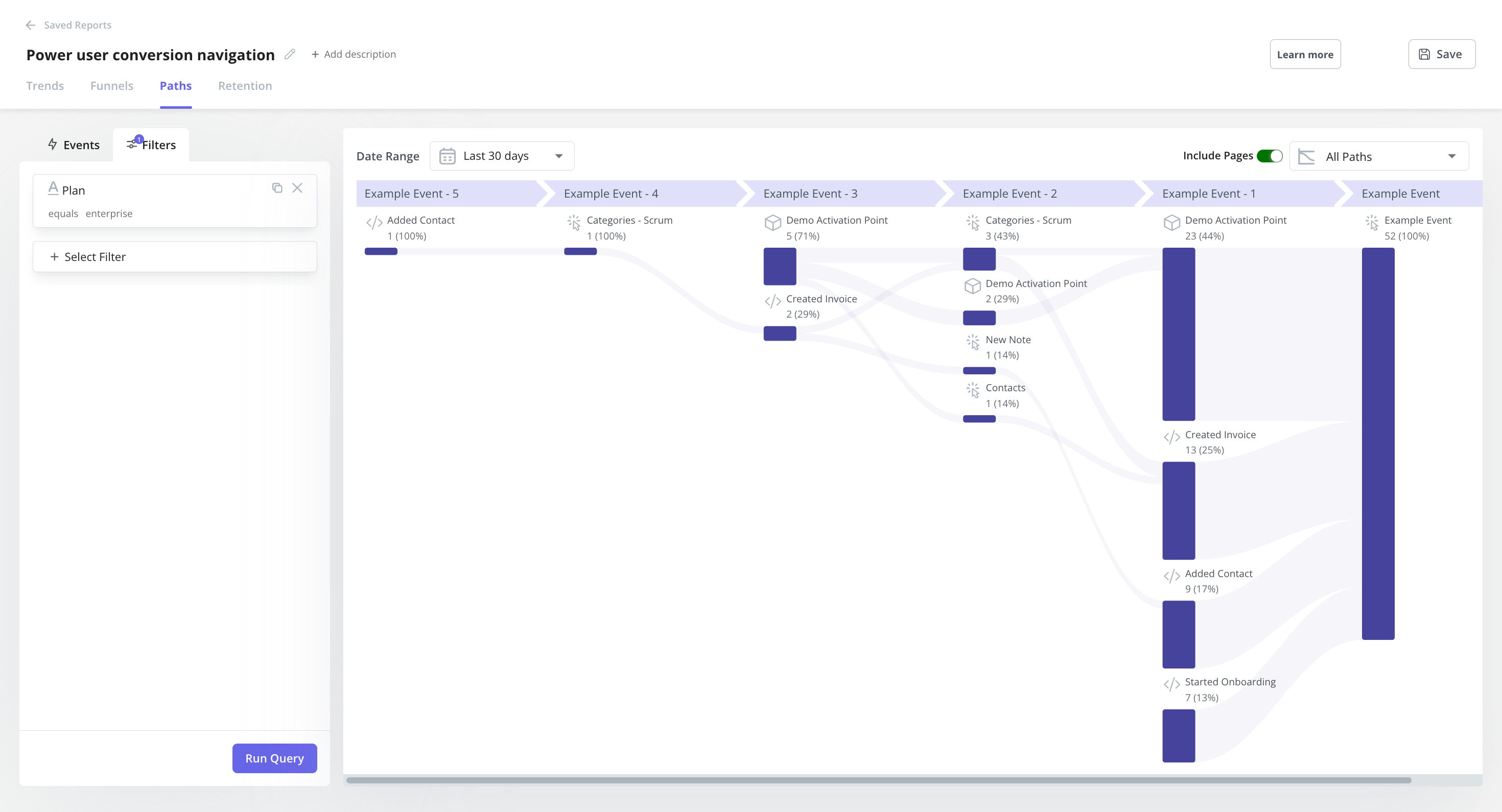
Improve the product experience by acting on customer feedback
Collecting customer feedback and user requests is an effective way to identify ways to offer a better product experience.
Apart from collecting feedback actively, provide users an opportunity to submit passive feedback and requests whenever they feel the need to do so. You can do it by adding a feedback widget to your resource center.
In your in-app surveys, make sure to include both closed-ended and open-ended questions so that you gather quantitative and qualitative data. It’s the latter that is the source of the most valuable insights.
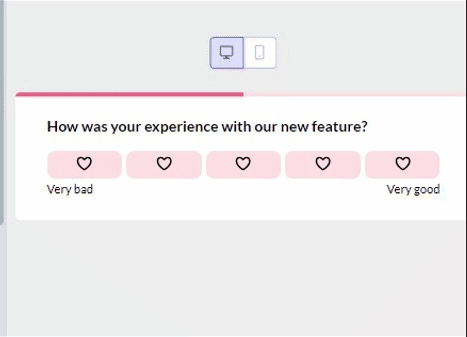
As users submit their feedback, make sure to close the feedback loop by acknowledging it and acting on it.
Pro tip: follow up on customer responses to get to the root cause of the problem before acting on user feedback or accommodating their requests.
Product-led growth metrics to monitor
There are a number of metrics that teams should track at different stages of the customer journey.
It’s good practice to assign each metric to one specific team as you’re mapping out your funnel. In this way, you will avoid confusion and increase the ownership.
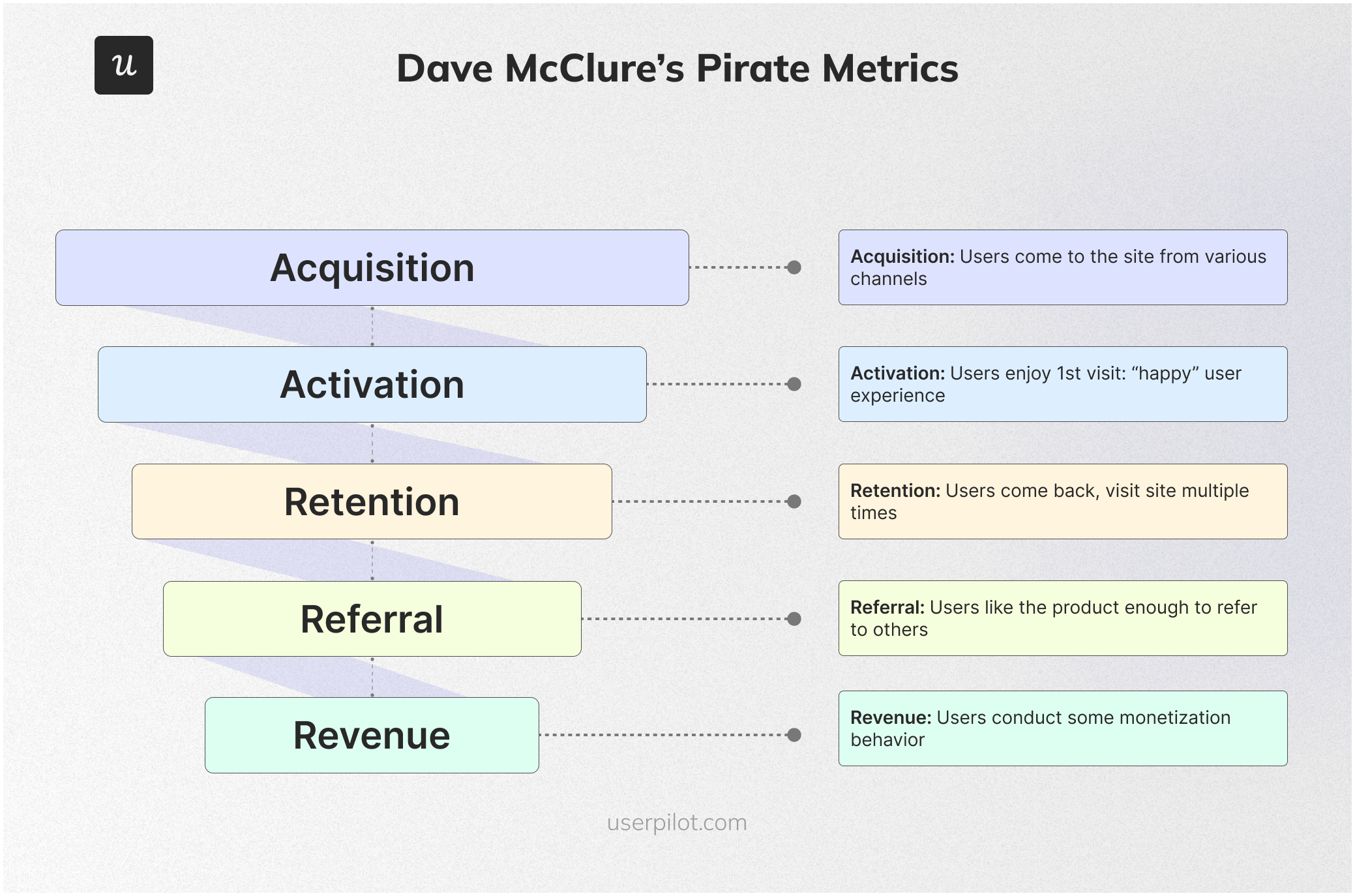
Acquisition stage metrics
The acquisition stage metrics that matter include:
- Customer acquisition cost (CAC) – the average cost of acquiring a customer
- Free trial sign-ups – it tells you how effective your acquisition efforts are
- Self-serve sign-ups – it’s an indication of the effectiveness of the self-serve channels
Activation stage metrics
The metrics to track at the activation rate include:
- Activation rate – the percentage of users reaching the activation stage
- Product-qualified leads (PQLs) – users who have experienced the product value and are likely to convert
- Time to Value (TTV) – how long it takes users to realize product value
Retention stage metrics
Relevant retention metrics include:
- Retention rate – the percentage of new users who are still using the product at the end of a period
- Churn rate – the percentage of new users who dropped out within a specific period
- User engagement – how active users are inside the product, for example, DAUs, WAUs, and MAUs
Referral stage metrics
You can measure the product performance at the referral stage by tracking:
- Net Promoter Score (NPS) – a measure of how likely users are to recommend the product to others
- Referral rate – the percentage of users who refer new users to the product
Revenue stage metrics
Important revenue stage metrics include:
- Monthly Recurring Revenue (MRR) – regular revenue generated by the product on a monthly basis
- Expansion revenue – revenue from upsells and cross-sells
- Customer Lifetime Value (CLV or CLTV) – the average revenue the customer brings during the duration of their relationship with the company
Examples of successful product-led companies
Now that we know how the product-led approach works, let’s check out a few companies that have successfully implemented product-led growth strategies.
Slack
Slack is one of the big PLG success stories.
When Slack launched in 2014, 8,000 users joined the platform on the first day, and 2 weeks later there were 15,000 of them. Currently, it’s estimated there are over 32 million daily active Slack users.
The company achieved this success through a range of PLG tactics.
In the lead-up to the launch, its beta testers played an important role in its initial success. Not only did they help refine the product, but also promoted it through word-of-mouth marketing.
New users had nothing to lose because Slack uses the freemium model. It allows users to explore the product and experience its value. To enable users to do so, Slack has created onboarding product tours and uses welcome surveys to customize the product experience.
However, the features in the free plan are limited, so it doesn’t satisfy all their needs. For example, the message history search is limited to 90 days. To drive upgrades, Slack uses subtle contextual in-app upsell prompts.

Canva
Canva is a graphic design app that uses PLG strategies to grow its customer base which currently sits at over 135 million users.
Just like Slack, Canva uses welcome surveys to personalize the product experience for its users.
By asking users about their roles, Canva is able to tailor the dashboard for the user so that they have easy access to relevant templates.
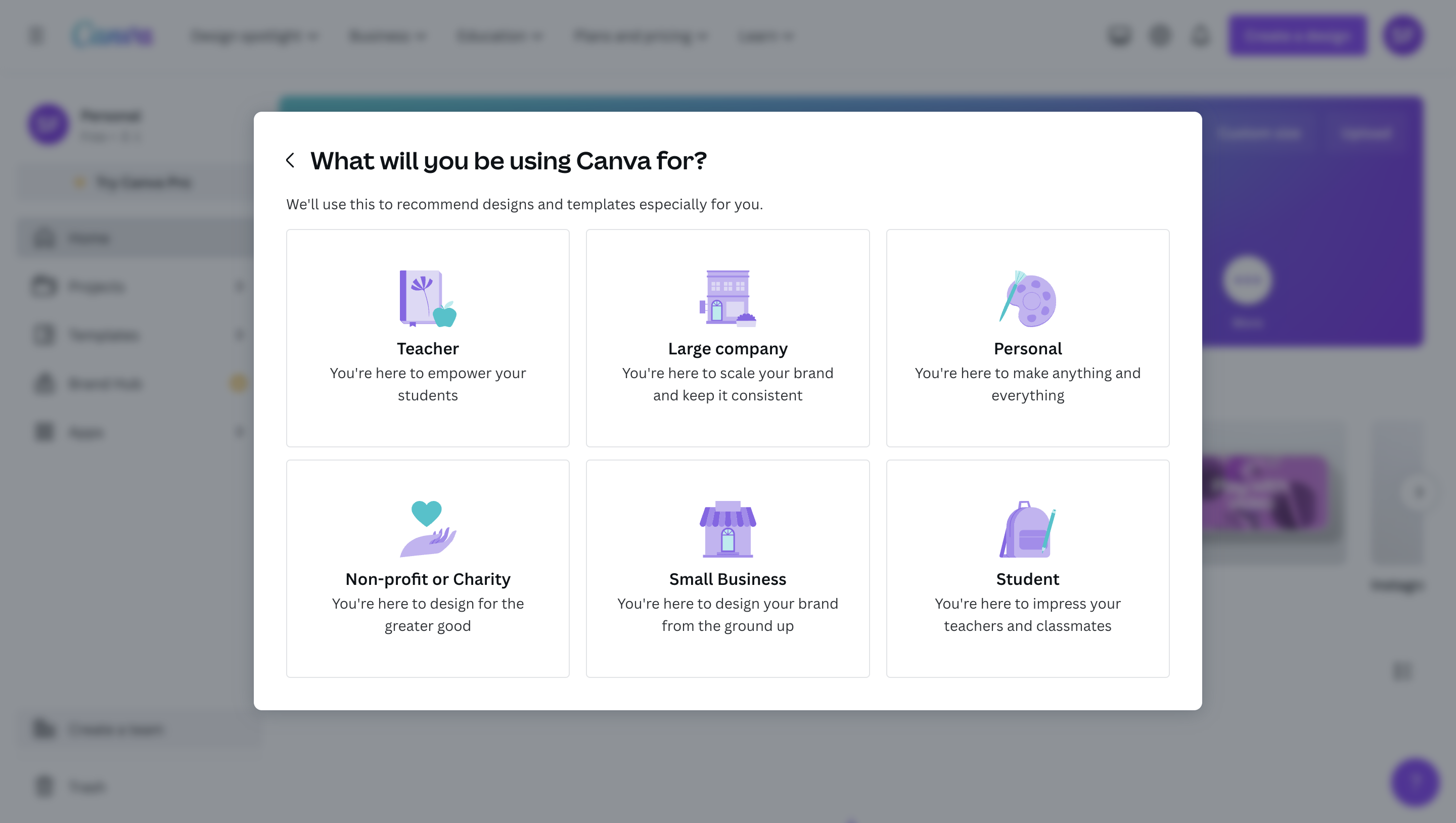
Canva offers a mixed product-led model. Its free functionality is pretty powerful and helps users achieve a lot of their objectives. However, to encourage upgrades, there are limitations on what users can do. For example, they can’t use all the templates or export files in higher resolutions.
Whenever a user tries to use one of the premium features, they’re prompted to upgrade to the paid plan. However, they don’t have to commit to the purchase just yet, as Canva offers a 30-day free trial period.
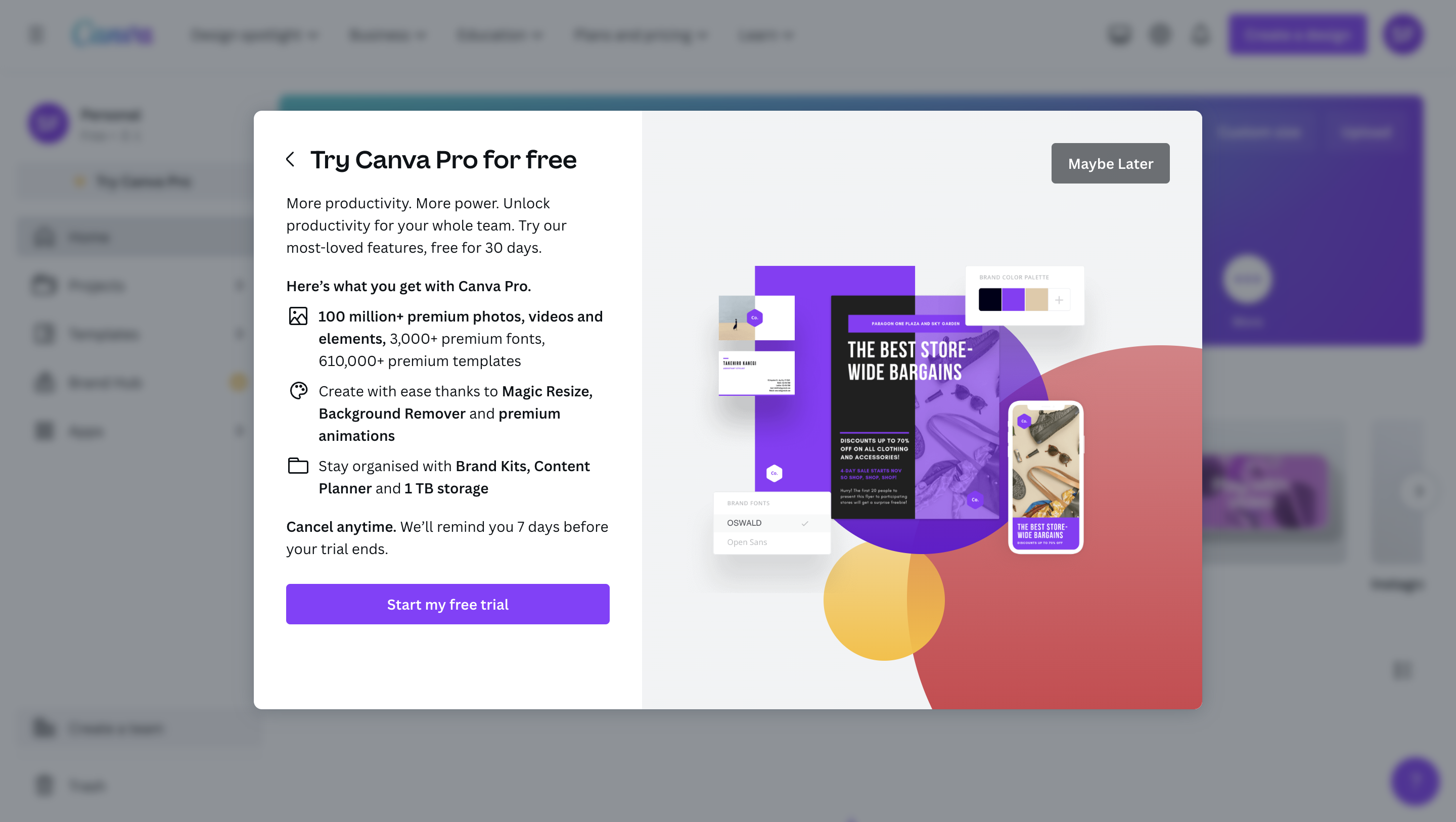
Grammarly
Grammarly is another ultra-successful PLG company with over 30 million daily users.
Most of the users are on the free plan.
To onboard new users, Grammarly provides demo content that’s riddled with errors that it can sort out. As users correct their mistakes, they learn how to use the product and experience its benefits firsthand.
Apart from grammar, punctuation, spelling, and stylistic mistakes, the demo text also contains issues that only the premium features can fix. This is the first attempt to convert new users into paying customers.
These efforts continue as users keep using the free product through contextual upsell prompts.
Grammarly uses in-app messages like beaming hotspots to help users discover new features and keep them engaged.

Userpilot – The best product-led growth tool for product and customer success teams
Userpilot is a no-code platform designed to support product-led growth. It simplifies user onboarding, gathers customer feedback, and provides in-depth product analytics — all in one place.
Here’s what it offers:
- Interactive experiences: Easily create checklists, walkthroughs, and in-app messages – making onboarding smooth and engaging. You can create native-looking designs with the WYSIWYG editor and localize the content for different languages.
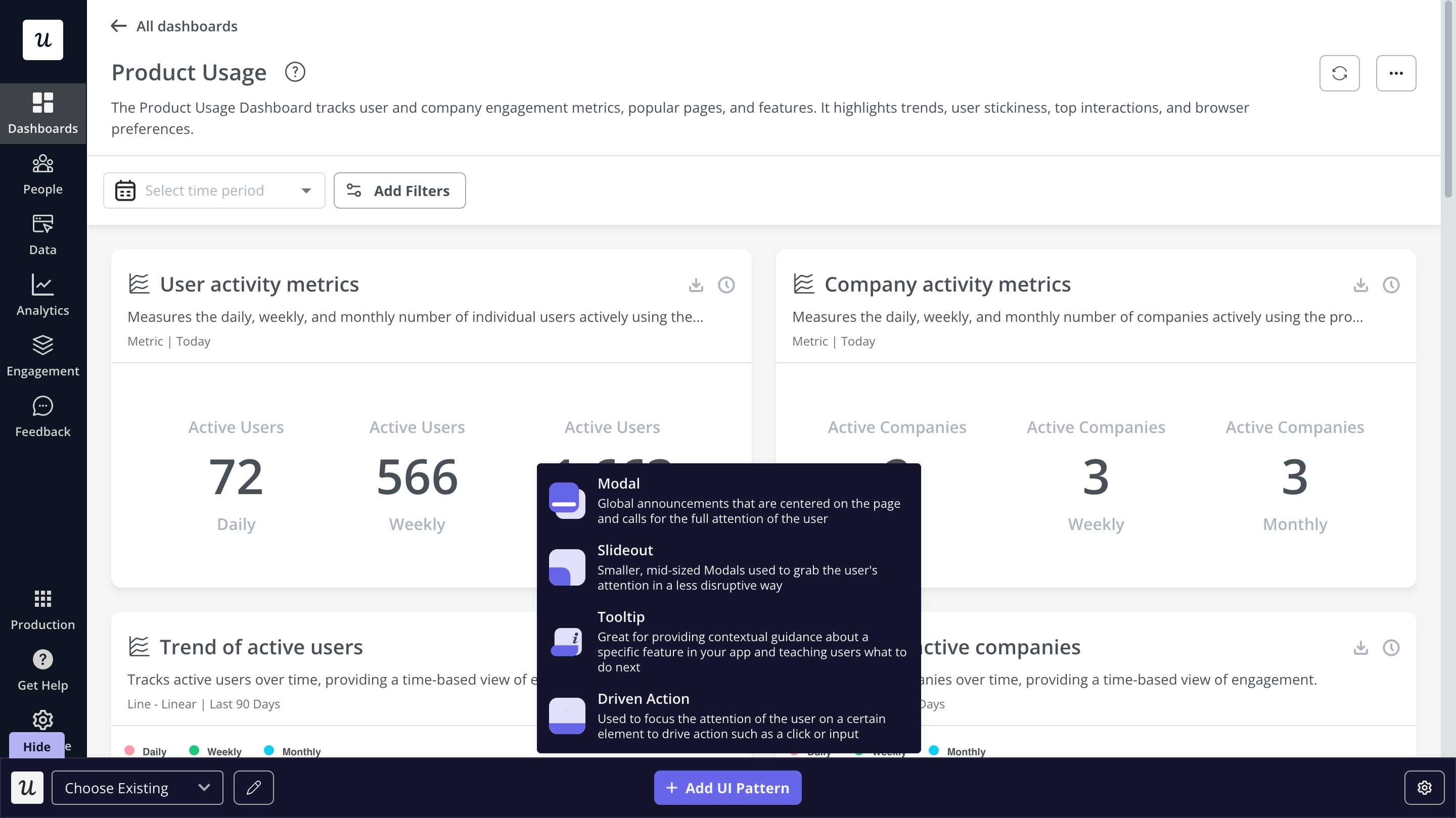
- Customer segmentation: Group your users based on their app usage (and other criteria) and deliver tailored messages. For instance, send personalized upsell messages depending on the features a certain segment uses.
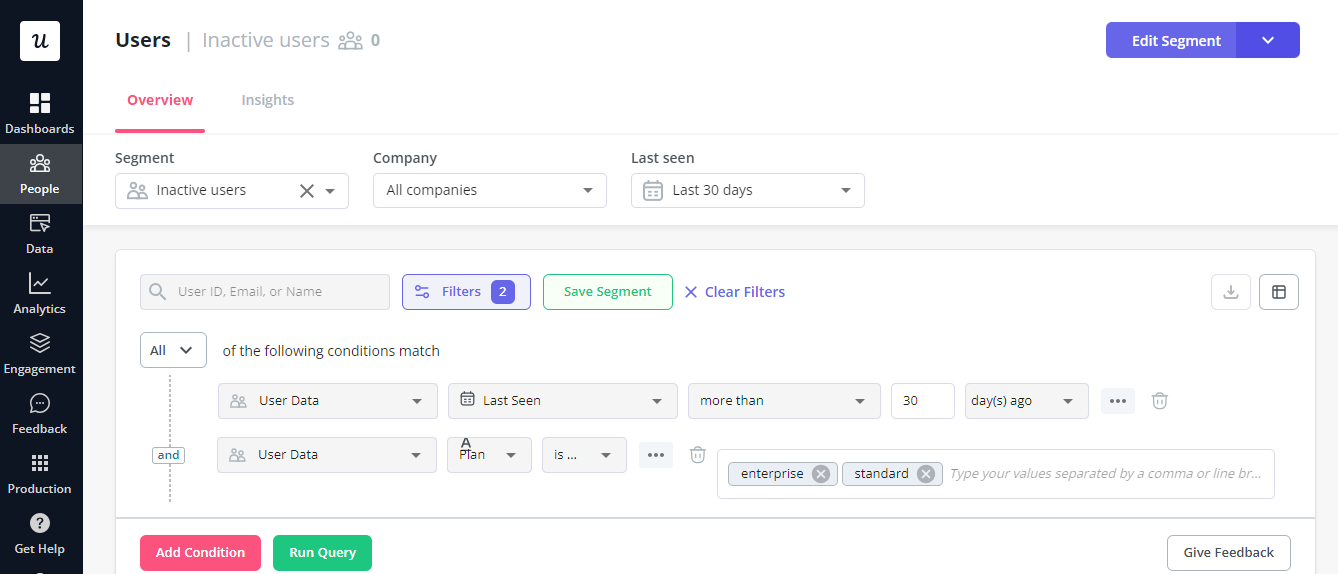
- In-app feedback: Gather customer feedback through built-in survey templates like CSAT and NPS to understand how users feel about your features.

- Product analytics: Monitor events, conduct advanced analyses (funnel, path, retention, and trend analyses), and monitor your product’s success on a visual dashboard.
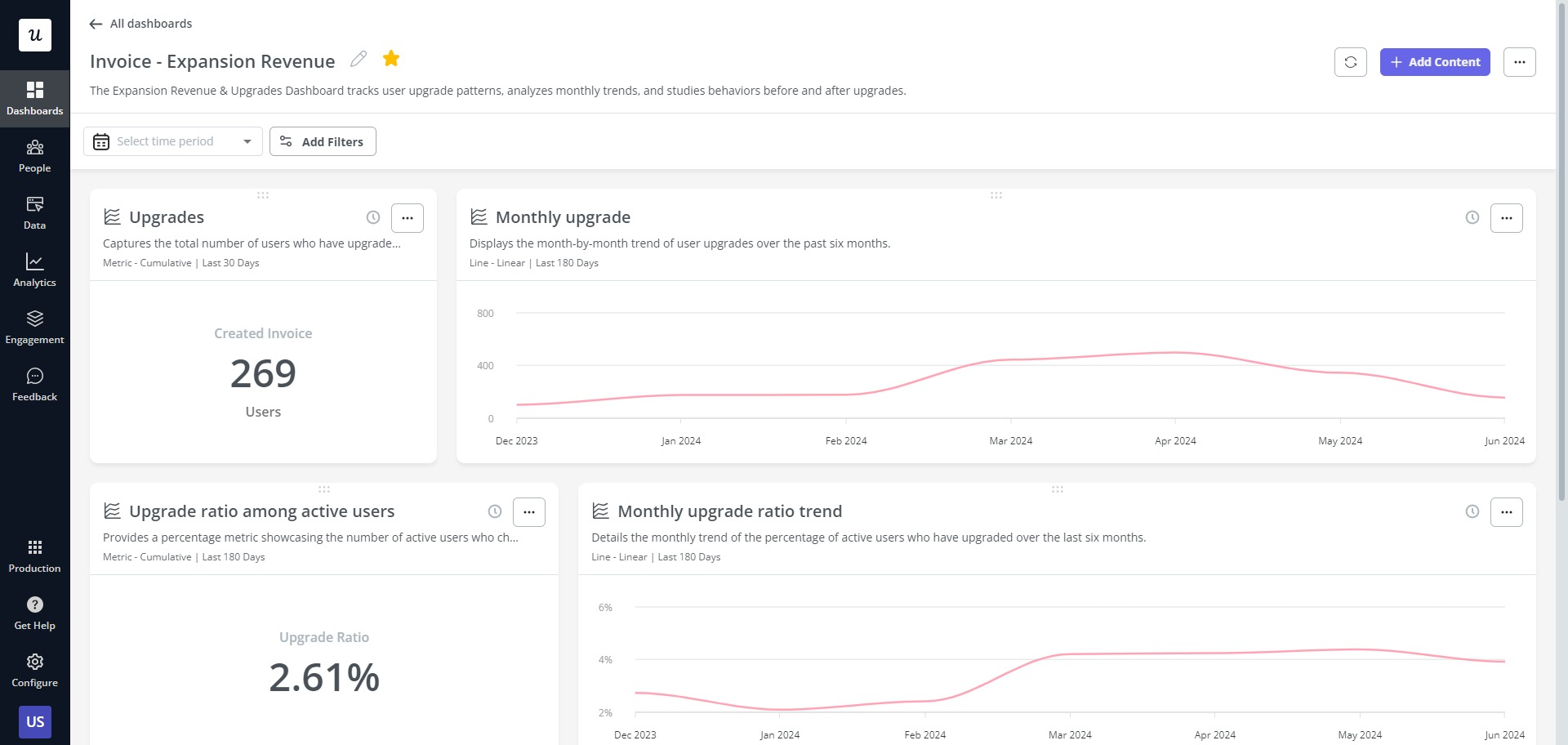
- Self-service support: Build an in-app resource center where users can find answers on their own or get help with more complex issues.
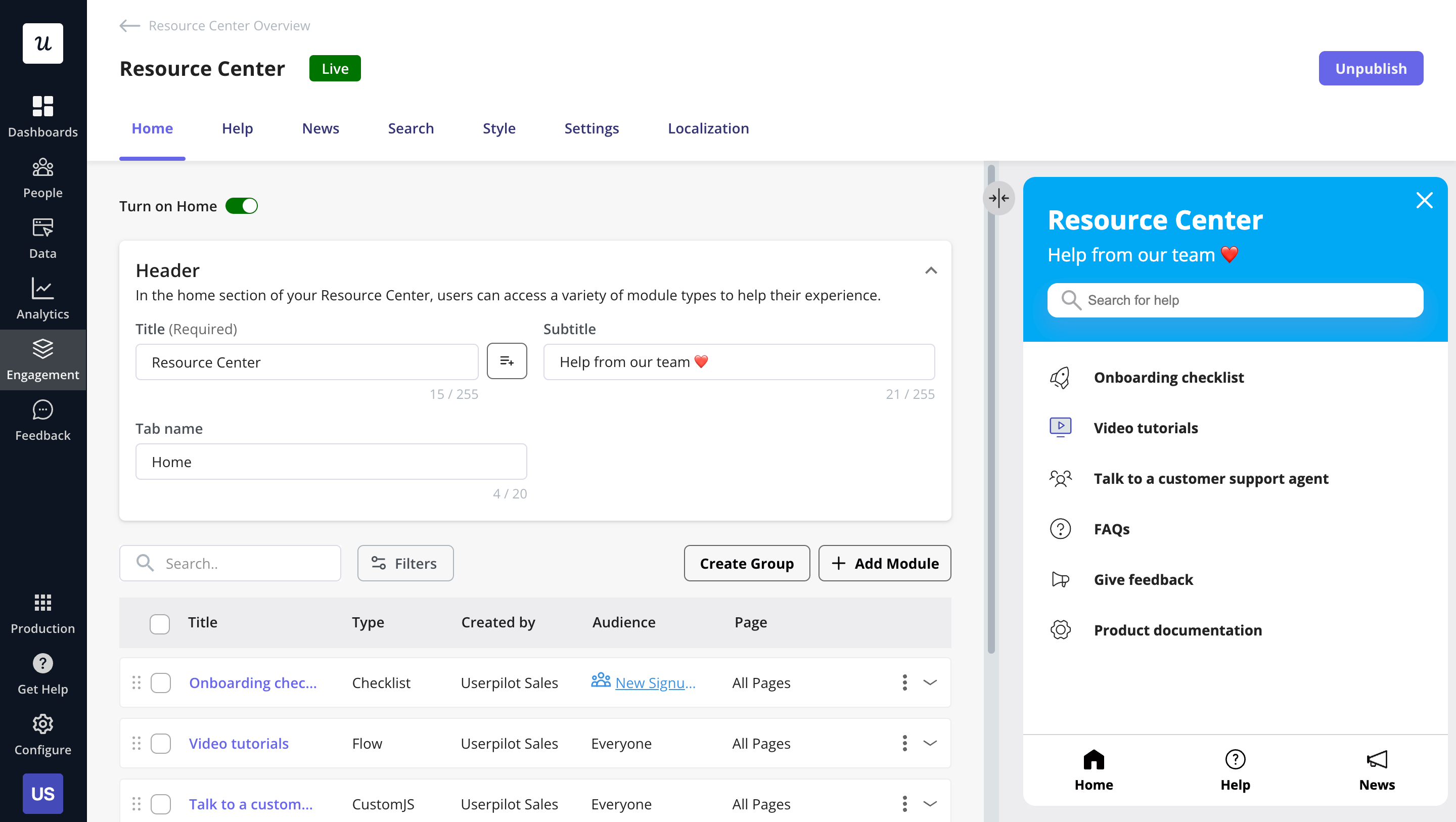
Here’s what one of Userpilot’s customers has to say about the tool:
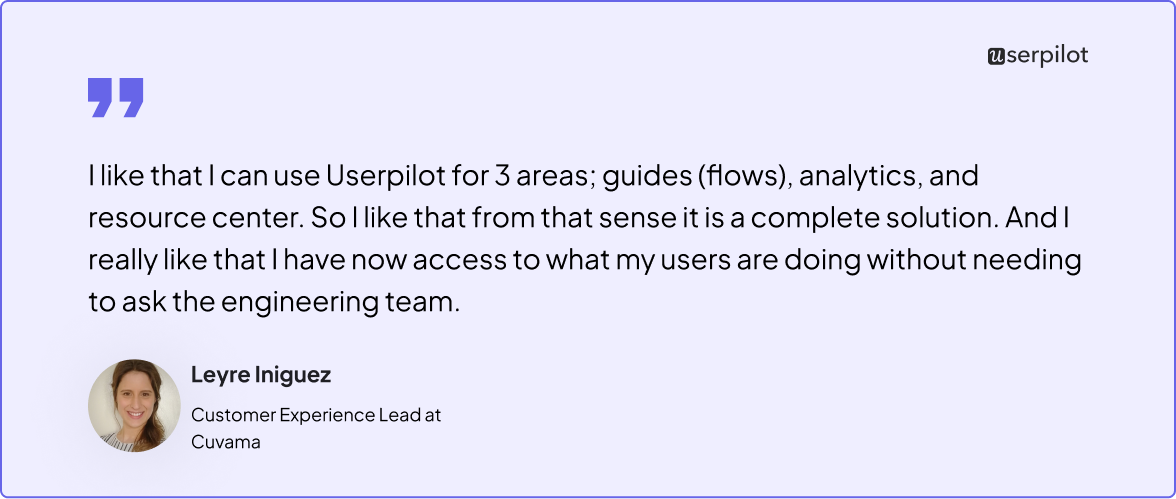
Frequently asked questions related to product-led growth
Here are some common questions and answers about product-led growth to help you understand this strategy better.
- What are the three pillars of product-led growth?
The three pillars of product-led growth are acquisition, activation, and retention. They focus on driving user growth through a seamless product experience, engaging onboarding, and ongoing value to retain customers
- What is the primary focus of product-led growth?
The primary focus of product-led growth is to use the product itself as the main driver of user acquisition, engagement, and retention – minimizing reliance on traditional sales and marketing tactics
- What is the difference between product-led growth and sales-led growth?
Product-led growth centers on using the product to attract and retain users, while sales-led growth focuses on using sales teams’ efforts to drive customer acquisition and conversion.
- What is the difference between PLG and PLS?
PLG uses the product to drive user acquisition and retention, whereas product-led sales (PLS) integrates product use with targeted sales efforts to convert and grow the clientele.
Conclusion
Product-led growth is a sustainable way to grow your business, but only if you do it right. To be successful with PLG, you need to build a robust product-led organization and adopt ways to maximize customer value.
If you want to see how Userpilot can support your PLG efforts, book the demo!



